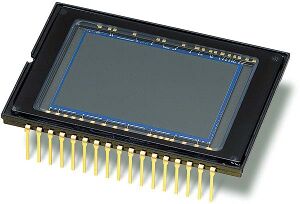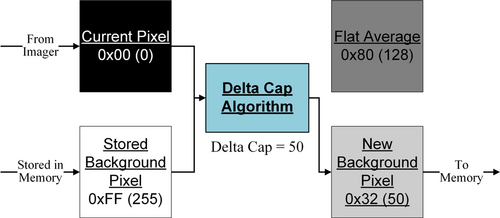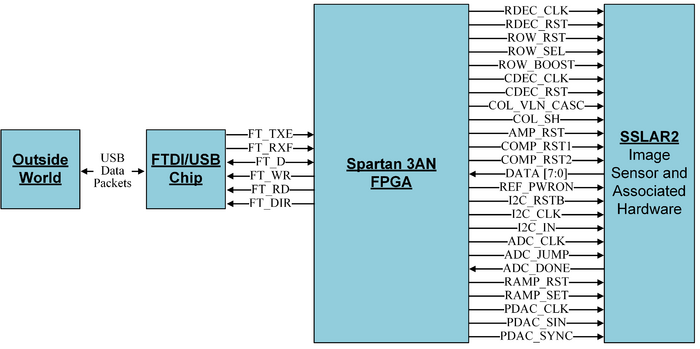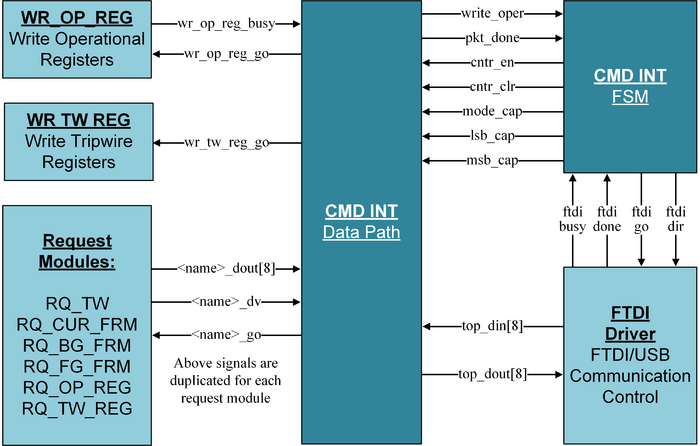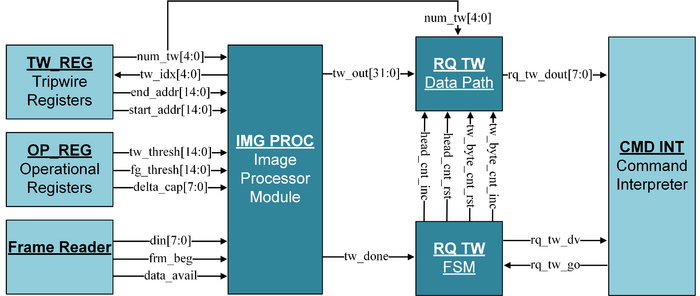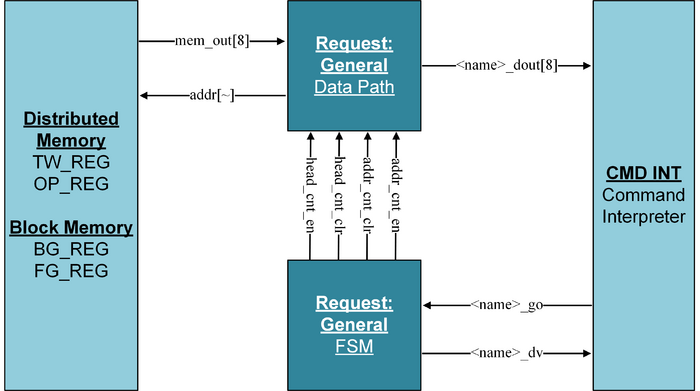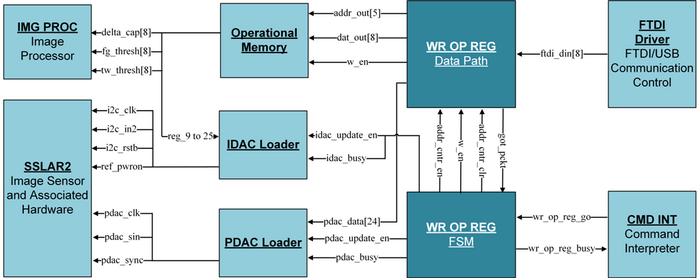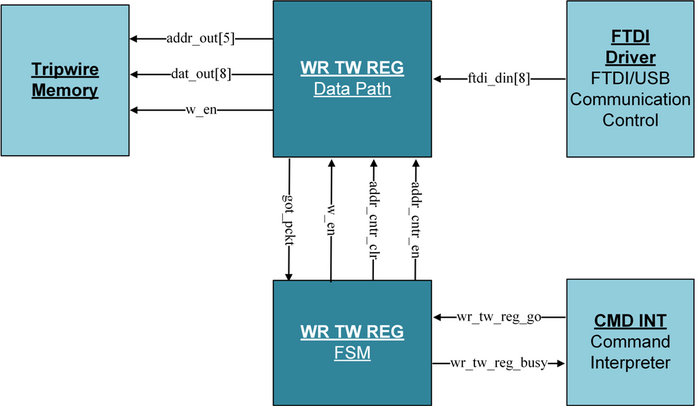Continuous Traffic Detection
| Team New Perspective | |
|---|---|
| Image Sensor | |
| Sponsors |
|
| Team Name | Team New Perspective |
| Duration | Fall 2013 - Spring 2014 |
| Faculty Advisor |
|
| Mentors |
|
In response to the need for real-time traffic control, less congestion, and reduced emissions, Team New Perspective has developed a unique vehicle speed detection system using a revolutionary low-power image sensor. The design is realized in hardware for future, single-chip implementations.
Background
None of the video detection systems currently in use in traffic signal system operations provide continuous traffic detection and monitoring needed for several advanced traffic control applications. Continuous monitoring of vehicle’s speed, location, and acceleration in the trapezoidal field of view (FOV) of the camera is done at the image sensor level intelligently without requiring complicated digital post processing of video streams and the high communication bandwidth associated with it. The proposed trapezoid image sensor IC will also reduce the overall cost and complexity of the system while providing intelligent and continuous incoming traffic information. These will open doors for several dynamic traffic signal control applications reducing vehicle emissions and fuel consumption due to unnecessary stopping.
Problem Statement
Modern traffic places much higher demands on monitoring and control devices than in the past. An intelligent image sensor and corresponding control system that is designed specifically for extracting only the dynamic properties of incoming traffic and the vehicles with high resolution, high speed, and embedded intelligence on a sensor level is needed.
Project Specifics
To detect traffic flow without the privacy issues that many current systems have, we have decided to use a method we have termed the “tripwire” method. Certain rows in the camera sensor pixel array will be monitored by the FPGA. When an object significantly different than the background passes across this “tripwire”, the row will “fire” and we will know that the leading edge of an object was at the tripwire. When it hits subsequent tripwires, we will know the same thing. If we know the length between the tripwires, gleaning speed information is easy. We are using the method of background subtraction to detect vehicles. This involves generating a background frame, reading the pixel array for a current frame, and subtracting the current frame from the background frame (resulting in a foreground frame) to see moving objects.
Delta Cap Method
We invented the delta cap method to help with the problem of foreground pixels being incorporated into the background too quickly. In a nutshell, when a pixel comes in from the SSLAR2, we compare it to our background and if it is a darker or lighter than the background, we let it change the background pixel value by a set parameter. This parameter we have termed 'Delta cap'.
Trip Wire Method
One of the key concerns with current methods of dynamic traffic control is privacy. To get around this issue, as well as high data rate issues, we decided to only look at certain rows of pixels we have termed "tripwires". When a car drives into this row, it is detected as a moving object. If the distance between the tripwires is known, the speed of the car can be calculated fairly easily by taking the time between two consecutive tripwires "firing", and dividing it by the distance between them.
System Overview
The following diagrams details the hardware interface for each part of our system. From right to left, the SSLAR2 image sensor, our control system implemented on an FPGA, the FTDI/USB chip, and the GUI/rest of the outside world.
The Image Sensor
The trapezoidal image sensor is shown below. Notice how the pixel density (pixels per square meter) stays relatively similar as you get farther from the camera. Notice also how the sensor mirrors the shape of the road. This allows for much better resolution at increased distances from the camera, while also allowing for much less image processing because we don't have to cut out the road from the image the camera sees.
The Control System
Below is an I/O flow diagram of our system. This system will be implemented on an FPGA with the end goal of making a single-chip Control System/Image Sensor duo.
Command Interpreter
The data flow diagram for the command interpreter is shown below. This module takes in all data from both the SSLAR2 camera and the outside world and pipes them to the correct internal module to be processed.
Image Processor
The Image Processor is the core block in our system. It performs all background subtraction and image processing algorithms, as well as generating the foreground, background, and current frames for the system.
The Request Modules
The following figure is a generalized module representing the four request modules in our system. Of these four modules, two (the Request Background Frame and the Request Foreground Frame) modules will access block memory, and two (the Request Trip Wire Register Status, and Request Operational Register Status) modules will access distributed memory. This is because multiple other modules will need to access them.
Operational Register Write Modules
The Operational Register Write Module takes commands sent through the FTDI driver to the Command Interpreter that control vital camera functions such as gain, contrast, etc.
Trip Wire Register Write Modules
The Trip Wire Register Write Module takes commands sent through the FTDI driver to the Command Interpreter that set the start and end addresses of trip wires, as well as the distance from a fixed reference point. This information is used to discern whether or not a trip wire has been "tripped", as well as detect a vehicles speed.
Testbed
The testbed will be used to test our design. As can be seen, there will be a stepper motor pulling a car with a counter weight attached. The car will pass through photogates that will be placed in such a way as to match up with the tripwires in our design. We can then check and see if the reading on the photogates matches the reading from our camera.
Project Sponsors
| Picture | Sponsor | Link |
|---|---|---|
| Suat Utku Ay, Ph.D. | Dr. Ay's Homepage | |
| National Institute for Advanced Transportation Technology (NIATT) Tranlive Program | NIATT | |
| VLSI Sensors Research Group (VSRG) | VSRG |
The Team
Faculty Mentor
| Touraj Assefi, Ph.D. | Dr. Assefi's Homepage |
Student Mentors
| Kyle Swenson:
Kyle grew up in Boise, Idaho and graduated from Boise High School in 2009. He has always had a strong interest in science, math and computers, which later matured into a passion for programming and digital systems engineering. Kyle loves working with FPGAs and microcontrollers and designing complex systems. After graduate school, Kyle plans on implementing embedded control systems with sensor networks. He intends to start his own business in embedded system contracting after working in the industry for a few years. Kyle has always been interested in learning more about himself and the world in which he lives, in an effort to grow as an individual and make the world a better place. |
CompE |
Project Members
| Jacob Grinestaff:
Jacob is a Senior in the Department of Electrical Engineering at the University of Idaho and will be graduating in May 2014. He is specializing in Microelectronics and will be working at Micron in the DRAM R&D Product Engineering group. He loves being outdoors and has participated in Intramural Frisbee, Soccer, Flag Football, Basketball, and Floor Hockey while at the U of I. His LinkedIn Profile is available here. |
EE | |
| Mitch Bodmer:
Mitch is a senior computer engineering student at the University of Idaho. He has experience in microcontroller programming and embedded system design as well as digital and analog circuit design. Mitch has also designed and built avionics for 2 pico-satelites at NASA Ames Research Center. In his spare time Mitch enjoys playing music, cooking, and side projects in electronics. |
CompE | |
| Frank Szeibert:
Francis ('Frank') is a senior in Electrical Engineering at the University of Idaho, and has specialized in controls and analog IC design. He has interned at Micron in the past where he worked in the fab designing and implementing ground-breaking process technologies for DRAM and flash memory. Frank enjoys school, running, and 'Sauced' (a local fry shop in Moscow). |
EE | |
| Carson Stauffer:
Carson is a senior in Computer Science at the University of Idaho. He is pretty awesome. |
CS | |
| Paul Bailey:
Paul is a senior at the University of Idaho where he is earning three degrees in the areas of Computer Science, Mathematics, and Physics. He currently works at the University of Idaho as a web developer. Paul also spends a significant amount of his time creating computer programming and mathematics video tutorials. |
CS |
Glossary of Terms
| Term | Definition |
|---|---|
| Rows | Pixels that run from one side of the street to another perpendicular to the flow of traffic |
| Columns | Pixels that run up and down the street parallel to the flow of traffic |
| Background | A frame recording the unmoving parts of the scene |
| Current Frame | The frame being used to extract foreground objects |
| Pixel Fill | The portion of a pixels shade that can be attributed to a foreground object. |
| Delta Cap | The maximum amount of change than can be applied to the background due to a new frame |
| Delta Breach | When a current frame pixel is more than one Delta Cap away from the corresponding background pixel |
| Foreground Threshold | The minimum difference between background and current frame pixels to register a foreground pixel |
| Tripwire | A row of pixels that is being monitored for foreground pixels |
Problem Specifications
Frame Rate
- 100fps from camera chip to FPGA
- 10fps data output to traffic controller
FPGA – Spartan 3E
Array Resolution – 640x480 (VGA) Data Rate
- Entire frame: 30.72 MB/s (burst x3)
- With Tripwires: 480MBx#Tripwiresx100fps
(burst x3) Field of View: 500m
Goals and Deadlines
Fall Semester 2013
Oct. 15: Snapshot #1
- Basic idea of FPGA design
- Geometry of Image Sensor
- Error Calculations
- Feasibility Study
Oct. 18: Wikipage meeting
Oct. 22: Tapeout
Dec. 6: Snapshot #2
- Have working demonstration of image subtraction algorithms in open CV
- Have FPGA design done
- Have all FPGA block diagrams done
- Have as much HDL written as possible
- Have test bed design done
Dec. 13: Portfolio, Wikipage, Logbook DUE
Spring Semester 2014
February 14th, 2014 - Detailed Design Review with Client
February 20th, 2014 - Design Review #2
- Simulations of all blocks completed and verified
- Majority of Documentation Done
- Wiki page up to date
- Implemented on Camera if possible
March 3rd, 2014 - Logbooks Due
March 4th, 2014 - Expo Registration and Information
March 11th, 2014 - Snapshot #3
April 8th, 2014 - Report Writing Workshop
May 2nd, 2014 - Engineering Design Expo
May 9th, 2014 - Final Report, Website, Logbooks
